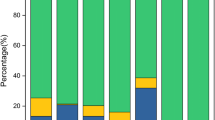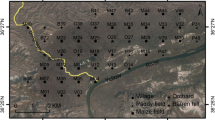Abstract
There is an increasing concern for potentially hazardous metals pollution, which can threaten crops production and human health. In this study, the spatial distribution and environmental risks of eight heavy metals in surface soil samples collected from the paddy fields in Yongshuyu irrigation area, Northeast China were investigated. The mean concentrations of Pb, Cr, Cu, Ni, Zn, Cd, Hg and As were 34.6 ± 4.67, 82.8 ± 9.51, 17.3 ± 4.09, 21.2 ± 12.0, 88.6 ± 17.9, 0.18 ± 0.15, 0.22 ± 0.07 and 8.77 ± 2.47 mg/kg, respectively, which were slightly higher than their corresponding background values of Jilin Province, indicating enrichment of these metals in the paddy soils, especially for Ni, Cd and Hg. The spatial distribution of heavy metals was closely correlated with local anthropogenic activities, such as agricultural production, mining and transportation. The hot-spot areas of As and Cd were mainly concentrated in the up-midstream where were associated with agricultural activities. Cr and Cu showed similar spatial distributions with hot-spot areas distributed the whole irrigation area uniformly. Ni was mainly distributed in the downstream where Ni quarries concentrated, while the spatial distribution patterns of Hg was mainly located in the upstream and downstream where the soil was significantly influenced by irrigation and coal mining emission. The spatial distributions of Pb and Zn were mainly concentrated along the highway side. The pollution levels of Yongshuyu irrigation area were estimated through index of geo-accumulation (Igeo), Nemerow integrated pollution index (NIPI) and potential ecological risk index (PERI). The results showed that Cd and Hg were the main pollutants in the study area. Health risk assessment results indicated that children were in higher non-carcinogenic and carcinogenic risks than adults with the carcinogenic metal of As. Ingestion was the main exposure pathway to non-carcinogenic and carcinogenic risk for both adults and children. Principal component analysis (PCA) indicated that Cr and Cu were mainly from parent materials, while Cd and As were mainly affected by agricultural activities. Pb and Zn were controlled by traffic activities, and the accumulations of Ni and Hg were associated with mining activities. This study would be valuable for preventing heavy metals inputs and safety in rice production of the Songhua river basin.
Similar content being viewed by others
References
Bhattacharya P, Welch A H, Stollenwerk K G et al., 2007. Arsenic in the environment: Biology and Chemistry. Science of the Total Environment, 379(2–3): 109–120. doi: 10.1016/j.scitotenv.2007.02.037
Bradstreet R B, 1954. Kjeldahl method for organic nitrogen. Analytical Chemistry, 26(1): 185–187. doi: 10.1021/ac60085a028
Cai Q, Long M L, Zhu M et al., 2009. Food chain transfer of cadmium and lead to cattle in a lead-zinc smelter in Guizhou, China. Environtal Pollution, 157: 3078–3082. doi: 10.1016/j.envpol.2009.05.048
Chai Y, Guo J, Chai S L et al., 2015. Source identification of eight heavy metals in grassland soils by multivariate analysis from the Baicheng-Songyuan area, Jilin Province, Northeast China. Chemosphere, 134: 67–75. doi: 10.1016/j.chemosphere.2015.04.008
Chen H W, An J, Wei S H et al., 2015. Spatial patterns and risk assessment of heavy metals in soils in a resource-exhausted city, Northeast China. Plos One, 10(9): e0137694. doi: 10.1371/journal.pone.0137694
Chen H Y, Teng Y G, Lu S J et al., 2015. Contamination features and health risk of soil heavy metals in China. Science of the Total Environment, 512–513: 143–153. doi:10.1016/j.scitotenv.2015.01.025
Cui Y J, Zhu Y G, Zhai R H et al., 2004. Transfer of metals from soil to vegetables in an area near a smelter in Nanning, China. Environment International, 30(6): 785–791. doi: 10.1016/j.envint.2004.01.003
Guo J H, Liu X J, Zhang Y et al., 2010. Significant acidification in major Chinese croplands. Science, 327(5968): 1008–1010. doi: 10.1126/science.1182570
Hakanson L, 1980. An ecological risk index for aquatic pollution control.a sedimentological approach. Water Research, 14(8): 75–1001. doi: 10.1016/0043-1354(80)90143-8
Huang Y, Chen Q Q, Deng M H et al., 2018. Heavy metal pollution and health risk assessment of agricultural soils in a typical peri-urban area in southeast China. Journal of Environmental Management, 207: 159–168. doi: 10.1016/j.jenvman.2017.10.072
Jiang Y X, Chao S H, Liu J W et al., 2017. Source apportionment and health risk assessment of heavy metals in soil for a township in Jiangsu Province, China. Chemosphere, 168: 1658–1668. doi: 10.1016/j.chemosphere.2016.11.088
Kashem M A, Singh B R, 2001. Metal avialability in contaminated soils. I. Effects of flooding and organic matter on changes in Eh, pH and solubility of Cd, Ni and Zn. Nutrient Cycling in Agroecosystems, 61(3): 247–255. doi: 10.1023/A:1013762204510
Ke X, Gui S F, Huang H et al., 2017. Ecological risk assessment and source identification for heavy metals in surface sediment from the Liaohe River protected area, China. Chemosphere, 175: 473–481. doi: 10.1016/j.chemosphere.2017.02.029
Li H H, Chen L J, Yu L et al., 2017. Pollution characteristics and risk assessment of human exposure to oral bioaccessibility of heavy metals via urban street dusts from different functional areas in Chengdu, China. Science of the Total Environment, 586: 1076–1084. doi: 10.1016/j.scitotenv.2017.02.092
Li X Y, Liu L J, Wang Y G et al., 2013. Heavy metal contamination of urban soil in an old industrial city (Shenyang) in Northeast China. Geoderma, 192: 50–58. doi: 10.1016/j.geoderma. 2012.08.011
Li Z Y, Ma Z W, Van Der Kuijp T J et al., 2014. A review of soil heavy metal pollution from mines in China: pollution and health risk assessment. Science of the Total Environment, 468–469: 843–853. doi: 10.1016/j.scitotenv.2013.08.090
Liu Huanhuan, Xu Yunlong, Zhao Jie, 2015. Determination of mercury and arsenic in soil by water bath digestion and microwave digestion-atomic fluorescence spectrometry. Journal of Anhui Agricultural Sciences, 43(16): 90–92. (in Chinese)
Liu P, Zhao H J, Wang L L et al., 2011. Analysis of Heavy Metal Sources for Vegetable Soils from Shandong Province, China. Journal of Integrative Agriculture, 10(1): 109–119. doi: 10.1016/S1671-2927(11)60313-1
Liu Q, Liu J S, Wang Q C et al., 2015. Assessment of heavy metal pollution in urban agricultural soils of Jilin City, China. Human and Ecological Risk Assessment: An International Journal, 21(7): 1869–1883. doi: 10.1080/10807039.2014.992854
Liu Q, Wang Y, Liu J S et al., 2014. Comparative assessment of heavy metals in suburban vegetable plots of Changchun, Dehui and Nongan, Northeast China. Fresenius Environmental Bulletin, 23(4): 1036–1044.
Lu A X, Wang J H, Qin X Y et al., 2012. Multivariate and geostatistical analyses of the spatial distribution and origin of heavy metals in the agricultural soils in Shunyi, Beijing, China. Science of the Total Environment, 425: 66–74. doi: 10.1016/j.scitotenv.2012.03.003
Lu X W, Wang L J, Li L Y et al., 2010. Multivariate statistical analysis of heavy metals in street dust of Baoji, NW China. Journal of Hazardous Materials, 173(1–3): 744–749. doi: 10.1016/j.jhazmat.2009.09.001
Luo W, Lu Y L, Zhang Y et al., 2010. Watershed-scale assessment of arsenic and metal contamination in the surface soils surrounding Miyun Reservoir, Beijing, China. Journal of Environmental Management, 91(12): 2599–2607. doi: 10.1016/j.jenvman.2010.07.023
Man Y B, Sun X L, Zhao Y G et al., 2010. Health risk assessment of abandoned agricultural soils based on heavy metal contents in Hong Kong, the world’s most populated city. Environment International, 36(6): 570–576. doi: 10.1016/j.envint.2010.04.014
Martín J A R, Arias M L, Corbí J M G, 2006. Heavy metals contents in agricultural topsoils in the Ebro basin (Spain). Application of the multivariate geoestatistical methods to study spatial variations. Environmental Pollution, 144(3): 1001–1012. doi: 10.1016/j.envpol.2006.01.045
Meng Xianxi, Li Shengzhi, 1995. Study on Background Value of Soil Environment of the Jilin Province. Beijing: Science Press. (in Chinese)
MEPC (Ministry of Environmental Protection of the People’s Republic of China), 1997. GB/T 17138–1997 Soil Quality-determination of Copper, Zinc-Flame Atomic Absorption Spectrophotometry. Beijing: Standards Press of China. (in Chinese)
MEPC and SBTS, (Ministry of Environmental Protection of the People’s Republic of China and State Bureau of Technical Supervision), 1995. GB 15618–1995 Environmental Quality Standard for Soils. Beijing: Standards Press of China. (in Chinese)
Micó C, Recatalá L, Peris M, et al., 2006. Assessing heavy metal sources in agricultural soils of an European Mediterranean area by multivariate analysis. Chemosphere, 65(5): 863–872. doi: 10.1016/j.chemosphere.2006.03.016
Müller G, 1969. Index of geoaccumulation in sediments of the Rhine River. Geojournal, 2: 108–118.
National Bureau of Statistics of China, 2014. Available at: https://doi.org/www.stats.gov.cn/tjsj/ndsj/2015/indexch.htm. (in Chinese)
Nelson D W, Sommers L E, 1982. Total carbon, organic carbon, and organic matter. In: Page A L (eds.). Methods of Soil Analysis. 2nd ed. Madison, WI, USA: Agronomy Society of America and Soil Science Society of America, 539–577.
Pan L B, Ma J, Wang X L et al., 2016. Heavy metals in soils from a typical county in Shanxi Province, China: Levels, sources and spatial distribution. Chemosphere, 148: 248–254. doi: 10.1016/j.chemosphere.2015.12.049
Qureshi A S, Hussain M I, Ismail S et al., 2016. Evaluating heavy metal accumulation and potential health risks in vegetables irrigated with treated wastewater. Chemosphere, 163:54–61. doi:10.1016/j.chemosphere.2016.07.073
Ran J, Wang D J, Wang C et al., 2016. Heavy metal contents, distribution, and prediction in a regional soil–wheat system. Science of the Total Environment, 544: 422–431. doi: 10.1016/j.scitotenv.2015.11.105
Shan Y S, Tysklind M, Hao F H et al., 2013. Identification of sources of heavy metals in agricultural soils using multivariate analysis and GIS. Journal of Soils & Sediments, 13(4): 720–729. doi: 10.1007/s11368-012-0637-3
Shi Pu, 2013. Suitability Evaluation on Land Reclamation of Mining Areas in Jilin City Based on GIS. Changchun: Jilin University. (in Chinese)
State Environmental Protection Administration, 2004. HJ/T 166–2004 The Technical Specification for Soil Environmental Monitoring. Beijing: Standards Press of China. (in Chinese)
Streets D G, Hao J M, Wu Y et al., 2005. Anthropogenic mercury emissions in China. Atmospheric Environment, 39(40): 7789–7806. doi: 10.1016/j.atmosenv.2005.08.029
Sun C Y, Liu J S, Wang Y et al., 2013. Multivariate and geostatistical analyses of the spatial distribution and sources of heavy metals in agricultural soil in Dehui, Northeast China. Chemosphere, 92(5): 517–523. doi: 10.1016/j.chemosphere.2013.02.063
Tepanosyan G, Maghakyan N, Sahakyan L et al., 2017. Heavy metals pollution levels and children health risk assessment of Yerevan kindergartens soils. Ecotoxicology and Environmental Safety, 142: 257–265. doi: 10.1016/j.ecoenv.2017.04.013
US. EPA, 1989. Risk Assessment Guidance for Superfund Volume I: Human Health Evaluation Manual: (Part A). Washington, DC: Office of Soild Waste and Emergency Response.
US. EPA, 1997. Exposure Factors Handbook. Washington, DC: Environmental Protection Agency.
US. EPA, 2001. Supplemental Guidance for Developing Soil Screening Levels for Superfund Sites. Washington, DC: Office of Solid Waste and Emergency Response.
US. EPA, 2011. Exposure Factors Handbook. Washington, DC: National Center for Environmental Assessment Office of Research and Development.
Vu C T, Lin C, Shern C C et al., 2017. Contamination, ecological risk and source apportionment of heavy metals in sediments and water of a contaminated river in Taiwan. Ecological Indicators, 82: 32–42. doi: 10.1016/j.ecolind.2017.06.008
Wang Hongyang, 2016. Jilin Yearbook. Beijing: China Statistics Press. (in Chinese)
Wang L J, Tao W D, Smardon R C et al., 2017. Speciation, sources, and risk assessment of heavy metals in suburban vegetable garden soil in Xianyang City, Northwest China. Frontiers of Earth Science, 1: 1–11. doi: 10.1007/s11707-017-0658-8
Xiao Q, Zhong Y T, Lu S G, 2015. Assessment of heavy metal pollution and human health risk in urban soils of steel industrial city (Anshan), Liaoning, Northeast China. Ecotoxicology and Environmental Safety, 120: 377–385. doi: 10.1016/j.ecoenv.2015.06.019
Yang Z P, Lu W X, Long Y Q et al., 2011. Assessment of heavy metals contamination in urban topsoil from Changchun City, China. Journal of Geochemical Exploration, 108(1): 27–38. doi: 10.1016/j.gexplo.2010.09.006
Yu Lei, Zhang Bai, Zhang Shuqing, 2004. Heavy metal elements pollution evaluation on the ecological environment of the Sanjiang plain based on GIS. Chinese Journal of Soil Science, 35(5): 529–532. (in Chinese)
Zhao L, Xu Y F, Hou H et al., 2014. Source identification and health risk assessment of metals in urban soils around the Tanggu chemical industrial district, Tianjin, China. Science of the Total Environment, 468-469: 654–662. doi: 10.1016/j.scitotenv. 2013.08.094
Zhu Lilu, Yan Baixing, Wang Lixia, 2011. Quantitative characteristics and source analysis of heavy metals in paddy soils in downstream of the Second Songhua River, Jilin Province. Chinese Journal of Applied Ecology, 21(21): 2965–2970. (in Chinese)
Author information
Authors and Affiliations
Corresponding author
Additional information
Foundation item: Under the auspices of ‘One-Three-Five’ Strategic Planning Principles of Northeast Institute of Geography and Agroecology, Chinese Academy of Sciences (No. IGA-135-08), Research Foundation for Talents of Northeast Institute of Geography and Agroecology, Chinese Academy of Sciences (No. Y6H1211001), National Natural Science Foundation (No. 41701372), Jilin Provincial Natural Science Fund Subject (No. 20180101318JC)
Rights and permissions
About this article
Cite this article
Cui, Z., Wang, Y., Zhao, N. et al. Spatial Distribution and Risk Assessment of Heavy Metals in Paddy Soils of Yongshuyu Irrigation Area from Songhua River Basin, Northeast China. Chin. Geogr. Sci. 28, 797–809 (2018). https://doi.org/10.1007/s11769-018-0991-1
Received:
Accepted:
Published:
Issue Date:
DOI: https://doi.org/10.1007/s11769-018-0991-1




